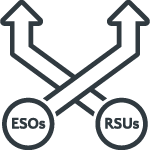 If you have incentive stock options, you’ve likely heard of — and perhaps already paid — the alternative minimum tax. This is the tax due in the years you exercise and hold incentive stock options, or ISOs.
If you have incentive stock options, you’ve likely heard of — and perhaps already paid — the alternative minimum tax. This is the tax due in the years you exercise and hold incentive stock options, or ISOs.
You might also be entitled to an AMT tax credit if that’s the case. The AMT credit gives you the ability to get back some or all of the AMT you paid when you sell your incentive stock option shares in a final sale.
Unfortunately, the AMT you pay and the AMT credit you might receive don’t always line up in a dollar-for-dollar offset.
If you sold your ISO shares, you may not have received the full AMT amount you paid in the form of a credit. Instead, you could have what’s known as a carryforward AMT credit.
A portion of the carryforward AMT credit will likely trickle back to you each year until the carryforward is fully exhausted, assuming you’re working and have wage income.
But what if you already retired and no longer have wage income to report?
FREE GUIDE
The Ultimate Guide to Incentive Stock Options
Learn the ins and outs of incentive stock options so you gain a better understanding of what you have.
Capturing the AMT credit can get more complicated in this case, and might warrant a change in your retirement income distribution strategy.
Here’s what you need to know.
A Review of One Retirement Income Distribution Strategy
“Where will my retirement income come from?” is a very common retirement planning question. Going from a reliable paycheck to an uncertain income stream is often a big hurdle for a new retiree to overcome.
While the process of distributing monthly income from investment accounts to mimic a paycheck is reasonably simple, the strategy behind the implementation isn’t always so straightforward.
One generally-accepted practice for taking retirement income is to distribute non-IRA money first, followed by tax deferred IRAs second, and Roth IRAs last.
This distribution technique is often an attempt to keep your income tax low and allow you to leverage tax-deferred growth for as long as possible. Some retirees can use distributions from a non-IRA so successfully that they don’t owe income tax at all — and that’s usually a good thing.
But depending on the particulars of your situation, it could also be a missed opportunity if you don’t “fill up” low income tax brackets by forcing taxable income from IRA distributions. The benefit of filling up low income tax brackets is the ability to take money out of taxable accounts a 0%, 10%, 15%, money that may otherwise be taxed at 20% or more if you take it out later.
This creative retirement income planning can be further complicated in your low taxable income retirement years if you also have a carry-forward AMT credit as the result of previously held incentive stock options.
If you have a carry-forward AMT credit, you likely need taxable income in order to get your AMT credit back– which means assuming you should follow the standard strategy and take your retirement income distributions from a non-IRA first, then an IRA second, then a ROTH IRA last might not be a good idea.
The Problem for the Alternative Minimum Tax Credit: Zero Taxable Income May Mean Zero AMT Credit
If you follow the standard process above and fund your retirement with distributions from a non-IRA account, you’ll likely need to sell investments within an account to create the necessary distributions.
When you sell investments, the amount that will be taxable will likely be equal to the difference between the cost basis (what you paid for the investments) and the final sale price (what you sell the investments for when you need to use the money).
Generally speaking, you will have one of the following outcomes:
- If the cost basis is lower than the final sales price = reportable taxable income
- If the cost basis is equal to the final sales price = no reportable income
- If the cost basis that is greater than the final sales price = reportable capital loss
Whether you receive short- or long-term capital gains tax rates on the proceeds will affect the amount of taxes you pay, as well — and if you’re too good at creating (or limiting) taxable income that you generate zero taxable income, both your regular tax and your tentative minimum tax may also be zero.
The potential negative of zero taxable income is that there is no opportunity for an AMT credit that year. Because no income means no credit, you essentially defer the credit that may otherwise be due to you.
How Taxable Income May Help You to Receive Your Alternative Minimum Tax Credit
How do you create taxable income during these low (reportable) income years — and more importantly, how do you know if it makes sense to do so?
One simple way to create taxable income is to take an IRA distribution. Generally speaking, an IRA distribution will be taxed as ordinary income in the year it is received.
Let’s look at an example of a single taxpaying using the standard deduction in 2019. Using Lacerte tax planning software, we know the total federal tax due if the only reportable income is a $100,000 IRA distribution, is $15,253.
$15,253 is a lot of money. You may wonder why you would deliberately force this into taxable income if the other option is to pay no income tax at all.
For one thing, a 15% tax rate is relatively reasonable. For another, you may pay even less than $15,253 if you factor in what is owed to you through the carryforward AMT credit.
We can continue this example to illustrate when forcing taxable income might make sense. Let’s continue the assumptions we’ve worked with so far, and also assume you retired with $200,000 worth of carryforward AMT credit.
When you calculate your tax return, your regular tax will still be $15,253. You also have a tentative minimum tax (TMT) of $ $7,358, and this is the tax calculation used to determine if and when you get your AMT credit back.
If you have carryforward AMT credit and your TMT is lower than your regular tax, you may be eligible for the AMT tax credit.
In this example, the AMT credit will be the difference between the regular tax and tentative tax, or $7,895. Your taxes due in this situation is $15,253 of regular tax, less $7,895 of AMT credit — or $7,358. Your carryforward credit then adjusts to $200,000 less $7,895, or $192,105.
Because of your ability to leverage the AMT credit in this example, a $100,000 distribution of IRA assets cost only $7,358 in tax, or 7.36%.
What If You Don’t Need the IRA Money?
All this being said, you may not want to force IRA distributions, even if they are at a favorable 7.36% average tax rate, if you have non-IRA assets you can use to fund your retirement. There’s still a reason to consider making this move even in this case, though.
Creative planning, like using Roth conversions, may make sense in low-income retirement years. In lieu of taking the IRA distribution as cash to spend, you can process the distribution as a Roth conversion.
It would look like this:
- You transfer $100,000 into a Roth IRA via a Roth conversion.
- You report $100,000 of taxable income.
- You pay tax on the $100,000 (assuming a 15% rate and the AMT credit, that’s $7,358).
- The money in the Roth continues to grow tax-deferred and will eventually be income tax free (assuming certain conditions are met).
The Impact of 10 Years of Roth Conversions Coupled with the Alternative Minimum Tax Credit
We already looked at how to secure a low tax bill on a $100,000 distribution if you have an AMT credit and a $100,000 IRA distribution.
But that just illustrated a single year. This strategy might look even more appealing when you see the financial impact of forcing taxable income via a Roth conversion coupled with the capturing the AMT credit can have over a decade.
Assume that you process a Roth conversion of $100,000 per year for 10 years and the annual federal tax cost (per our example above) is only $7,358. Let’s also assume that the money in the newly established Roth IRA earns 7% per year.
Here’s what the numbers look like when you run them out over 10 years:
- Total Income Taxes Paid: $73,580
- Total AMT Credit Used: $78,950
- Remaining AMT Credit: $121,050
- Future Roth IRA Value: $1,478,360
If you know how to use your AMT credit effectively in retirement, you can create a tax-deferred and income tax free bucket of nearly 1.5 million dollars at a tax “cost” of just $73,580.
The fact that Roth IRAs are not RMD eligible makes this an even better deal. You took $1.5 million of IRA dollars that would be subject to RMDs and moved them into an account that is RMD-free.
Using the Alternative Minimum Tax Credit in Retirement
Retirement income planning can be complicated in even the simplest scenario. It gets even more complicated when you add advanced tax planning and the AMT credit. But that complication may lead to opportunity for those versed with the knowledge.
If you transition into retirement with potentially low-income tax years and a carryforward AMT credit, it may be overly simplified to assume you should take distributions from a non-IRA first, then an IRA second, then a Roth IRA last.
If you follow this shortsighted track, you may be missing the opportunity to effectively utilize your AMT credit in the short and long term in a meaningful way.
By completing a bit of advanced tax, investment, and cash flow planning, you can develop a strategy that effectively accelerates some of your AMT credit sooner rather than later, and allows you to effectively reallocate your assets in a more tax efficient manner.
This material is intended for informational/educational purposes only and should not be construed as investment, tax, or legal advice, a solicitation, or a recommendation to buy or sell any security or investment product. Hypothetical examples contained herein are for illustrative purposes only and do not reflect, nor attempt to predict, actual results of any investment. The information contained herein is taken from sources believed to be reliable, however accuracy or completeness cannot be guaranteed. Please contact your financial, tax, and legal professionals for more information specific to your situation. Investments are subject to risk, including the loss of principal. Because investment return and principal value fluctuate, shares may be worth more or less than their original value. Some investments are not suitable for all investors, and there is no guarantee that any investing goal will be met. Past performance is no guarantee of future results. Talk to your financial advisor before making any investing decisions.













A very well written blog. I enjoyed reading and get to know about ATM credits. Thanks for sharing.